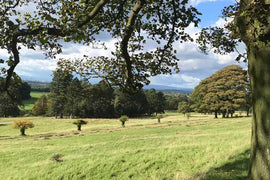Greenfleet has been working with the NSW National Parks and Wildlife Service (NPWS) since 2008 to revegetate a number of sites within Kosciuszko National Park. Five separate sites are undergoing a Greenfleet transformation, with a total area of approximately 442.5 hectares.
Primarily used for grazing prior to being incorporated into Kosciuszko National Park in1967, natural regeneration at these sites has been slow and sporadic because of weed infestation, kangaroo and pest animal populations, and compacted soils.
Respecting Indigenous Heritage
The area has a rich indigenous history. It was traditionally occupied by both the Ngarigo Walgulu people and the Southern Ngunnawal people, who fished the Snowy River and used the rivers rocks for making tools, and during the summer months they travelled up the mountains to feast on the Bogong Moths.
Indigenous artifacts were uncovered during site preparation at one of the planting sites, revealing one of the routes used to reach the alpine areas in search of Bogong Moths. As a result, some areas have been spot planted by traditional owners to preserve historic artifacts and respect traditional pathways.
Rising To The Challenge
Revegetating such an iconic region is not without its challenges – the local climate can be harsh, and weeds and pest animals need to be managed to give our revegetation projects the best growing conditions possible, and eventually returning the area back to a more natural ecosystem and encouraging the return of many native plant and animal species that used to occur in the area.
Greenfleet initially planted the 166.5 hectare Kalkite Waters site in May 2009, however the planting took place at the wrong time of year and severe frost killed many of the immature seedlings.
While Kalkite Waters is a large, challenging site with significant risks, Greenfleet is committed to replanting this iconic site, so we have reviewed where we went wrong and changed our strategy. We are now replanting the site in stages over several years, with each planting taking place later in the year to reduce the risk of frost. The area replanted in 2010 showed good results when we return for monitoring in March 2011.
Revegetation projects at Humes Crossing and Log Bridge (a site overlooking the Blowering Dam) also experienced some early challenges, with rabbits eating some of the young seedlings in the first year, leaving some patches entirely without trees. Replanting the affected areas, along with increased rabbit control measures, has improved survival at these sites and they are now expected to deliver the desired carbon and revegetation outcomes.
During our recent visit, we witnessed excellent bird life and diversity throughout the sites. Species observed included eastern rosellas, lorikeets, dusky woodswallows, emus and fairy wrens. Kangaroos and wombats are also common onsite utilising the trees for shelter. The forest is taking shape and the trees are growing strong.

Location Size
Planting Dates
Species
- Eucalyptus blakelyi
- Eucalyptus melliodora
- Eucalyptus macrorhyncha
- Eucalyptus nortonii
- Eucalyptus goniocalyx
- Acacia doratoxylon
- Acacia implexa
- Acacia melanoxylon
- Brachychiton populneus
- Dodonaea viscose
- Kunzea parvifolia




